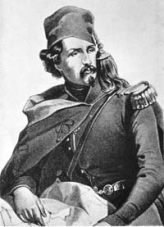Louis Juchault de Lamoricière facts for kids
Quick facts for kids
Christophe Léon Louis Juchault de Lamoricière
|
|
|---|---|

Portrait of Lamoricière, c. 1860s
|
|
| Born | 5 September 1806 Nantes, France |
| Died | 11 September 1865 (aged 59) Prouzel, France |
| Allegiance | |
| Years of service | 1828–1851; 1860 |
Christophe Léon Louis Juchault de Lamoricière (born September 5, 1806 – died September 11, 1865) was an important French general. He was known for his military skills and his role in French politics during the 1800s.
Contents
Early Life and Education
Christophe de Lamoricière was born in Nantes, a city in France. When he was young, he attended two famous schools. He studied at the École Polytechnique, which is a top engineering school. After that, he went to the École d'Application to learn more about military engineering.
Military Career Begins
In 1828, Lamoricière officially joined the army as a sub-lieutenant in the Engineers. This meant he was a junior officer in a part of the army that built and maintained military structures.
Service in Algeria
Lamoricière spent many years serving in Algeria, starting in 1830. At that time, France was trying to take control of Algeria. He quickly showed his talent and became a captain of the Zouaves, who were special infantry soldiers.
By 1840, Lamoricière had become a maréchal-de-camp, which is like a major-general today. Just three years later, he was promoted again to general of division. He was one of the best and most effective generals working under General Bugeaud. Lamoricière played a key role in the battle of Isly on August 14, 1844, where the French army won an important victory.
He even served as the temporary governor-general of Algeria, which meant he was in charge of the French administration there for a time. His biggest achievement in Algeria was capturing Abd-el-Kader in 1847. Abd-el-Kader was a leader who had been fighting against French rule for many years.
Political Role in France
Lamoricière was also involved in the political changes in France in 1848. He was a member of the Chamber of Deputies, which was like a parliament. He also held a military command during this time of unrest.
Under the government of General Cavaignac, Lamoricière served as the Minister of War from June 28 to December 20, 1848. This made him responsible for the entire French military.
Opposing Louis Napoleon
From 1848 to 1851, Lamoricière was a strong opponent of Louis Napoleon, who later became Emperor Napoleon III. Lamoricière disagreed with Louis Napoleon's policies. Because of this, after Louis Napoleon's coup d'état (a sudden takeover of power) on December 2, 1851, Lamoricière was arrested and sent out of the country. He refused to support the new Emperor Napoleon III.
Leading the Papal Army
In 1860, Lamoricière accepted a new challenge. He took command of the papal army, which was the army of the Pope. He led this army during the Italian campaign of 1860. However, on September 18 of that year, his forces were badly defeated by the Italian army at the Battle of Castelfidardo.
Later Life and Legacy
After his military service to the Pope, Lamoricière spent his final years living quietly in France. He had been allowed to return to his home country in 1857.
He passed away in 1865 in Prouzel, France. His tomb, a special monument, is located in the Nantes Cathedral. It was designed by the sculptor Paul Dubois and finished in 1875.
Images for kids


